The piece of the month of June 2021
THE TRINITY OF ARRE, A BROKEN PAINTING BY NARCISSUS
María Josefa Tarifa Castilla
University of Zaragoza
In March 2019, the work under attention, a 57 x cm oil on canvas attributed to the painter A. Rota under the degree scroll Palace with bridge, was put up for sale in a well-known national auction house. The painting was acquired by a private individual from Navarre, who has made the painting available to us for this study.
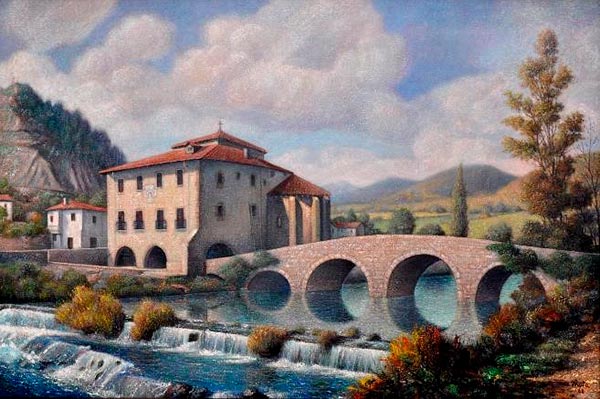
Narciso Rota, The Trinity of Arre, 1988. Private collection. Photo: M.ª Josefa Tarifa.
A detailed analysis of the canvas has allowed us, on the one hand, to refine the authorship of its creator and, on the other, to correctly identify the beautiful landscape and the emblematic Navarrese building represented. Undoubtedly, we are before a work from the hands of the prolific contemporary artist Narciso Rota (San Sebastian, 1926-Pamplona, 2004). The fascination of this San Sebastian-born artist for painting manifested itself at an early age, starting his training at the age of fourteen, when he entered the studio of Gaspar Montes Iturrioz, one of the main artists of the Bidasoa School, completing his apprenticeship later at the School of Arts and Crafts of Irun. Rota's curiosity and interest in discovering new techniques led him in the forties to become an apprentice at business Porcelanas del Bidasoa, later gaining a place as a decorator and draftsman at the San Telmo Museum in San Sebastián, at that time under the direction of Manso de Zúñiga.
In the mid-fifties, the artist accepted an offer to set up a workshop dedicated to the production of porcelain and enamels in Pamplona, known as "Talleres Limoges", located in Tejería Street, where he also set up his painting studio. This led him to set up his residency program in the Navarrese capital together with his wife, Aurora Elberdin, where he became close friends with the painters Jesús Basiano (1889-1966) and Crispín Martínez (1903-1957). In the mid-1970s, the couple bought another house in the town of Yesa, where they spent long periods of time, and our protagonist actively collaborated in the different Cultural Activities Office organized by the town, such as the charanga, as he was also passionate about music, playing several instruments such as the chistu, the atabal or the accordion. Throughout his life he exhibited on several occasions in Pamplona, in the conference room of Exhibitions of the Círculo de Bellas Artes in Madrid, Sangüesa, Irurita and in Bayonne (France). He spent the last years of his life with his wife at residency program Ama Ibañeta in Erro, where he continued painting until 2003, when he suffered a stroke and died a year later, on August 17, 2004.
The wide artistic production of Narciso Rota, in oil and watercolor, which also includes the aforementioned enamels and porcelains, is scattered in various museums and countless private collections, as is the case of the painting that concerns us. The subject matter of his oil paintings is predominantly landscapes, which on the other hand denotes his love for nature, of Basque content in the first phase, becoming mostly Navarrese subjects in his Pamplona stage, from urban views, such as emblematic corners of the old quarter of Pamplona, for example, the place del Castillo, Mercaderes Street, the cathedral and the church of San Cernin, or also countless places of Navarre's geography, such as the Baztan Valley, Sangüesa, Roncesvalles, Isaba, Estella and Aóiz, among others. These works are a clear evocation of French impressionism, which Rota admired so much, and from whose main artists he drank in his training, such as Manet, Monet or Seurat, and from these masters he inherited a fresh and loose painting, developing it in a heterodox way and staff.
All these features are perceptible in the painting under study in this text, a characteristic work of Narciso Rota's artistic production in the 80's, due to its subject matter, technique and use of color and light. It is a landscape of great vitality and strength, executed in the impressionist style, with a loose brushstroke, which in turn combines with a well-pasted paint, as can be seen in the bushes represented in the foreground at the foot of the road or those growing in the middle of the river course, to which he also adds touches of pointillism. It is a canvas executed with a varied chromatic palette, in which the real protagonists are the light and the color that Narciso Rota reproduces with photographic fidelity, both of nature and of the buildings and architectural Structures that are the protagonists of the scene, without including human figures, with a great attraction for the eye.
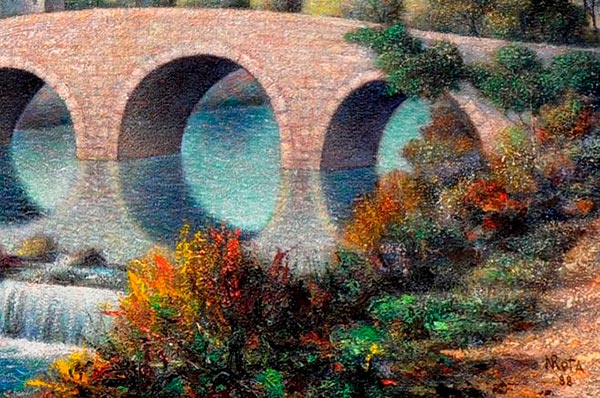
Narciso Rota, The Trinity of Arre, 1988. Private collection. Detail. Photo: M.ª Josefa Tarifa.
Precisely the landscape and architectural realism of the objects represented has allowed us to identify, without any doubt, subject , this beautiful place of Navarre's geography in which is located a significant architectural ensemble of the medieval historical-artistic heritage, the stone bridge and the basilica of the Holy Trinity of Arre, emblematic point of the Way of St. James in Navarra.
The picture presents a view painted from the current street group Martiket Taldea that follows the slope of the Ulzama River at the fork of the French Camino de Santiago, while the pilgrimage path to Santiago de Compostela continues across the bridge, an architectural structure 55 meters long and six arches whose grayish stone ashlar quartering is masterfully reproduced by the artist. Rota pays great attention to the reflection in the crystalline water of the river of five of the rounded arches of the bridge, whose serene flow is altered as it rushes over the two small waterfalls that this river course presents just before the fulling mill of Villava, which is not seen in the canvas, located on the left on the same bank as the temple of the Trinity.
This Romanesque bridge, located at the exit of Villava, had great importance during the Age average and in the coming centuries, to facilitate the passage over the river Ulzama to the pilgrims of the Way of Santiago that from Roncesvalles arrived by the Valley of Erro and Esteríbar to the locality of Huarte, after skirting the Miravalles mount. Its current appearance is the result of the reforms it underwent in the 18th century, with the widening of the road, and the latest interventions undertaken in the 1960s with the repair of those areas that were seriously deteriorated.
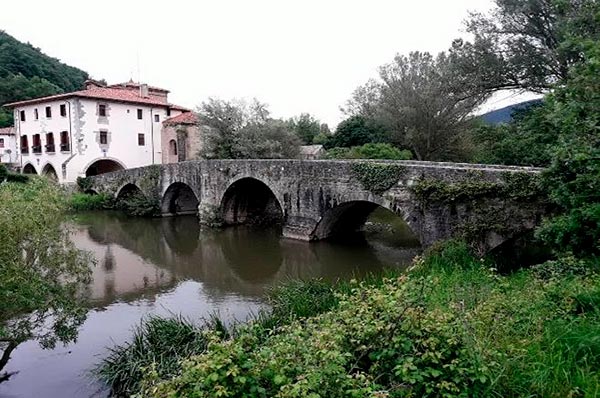
Current view of the medieval bridge and the Trinity of Arre. Photo: M.ª Josefa Tarifa.
At the foot of the other end of the bridge stands the Basilica of the Trinity of Arre, located almost at the border with Villava, a Romanesque building that from the beginning had a hospital and pilgrims' hostel, run by two brotherhoods, one ecclesiastical and the other lay, of which documentation is preserved from the sixteenth century that has been studied in depth by Marist Brother Víctor Pastor Abáigar.
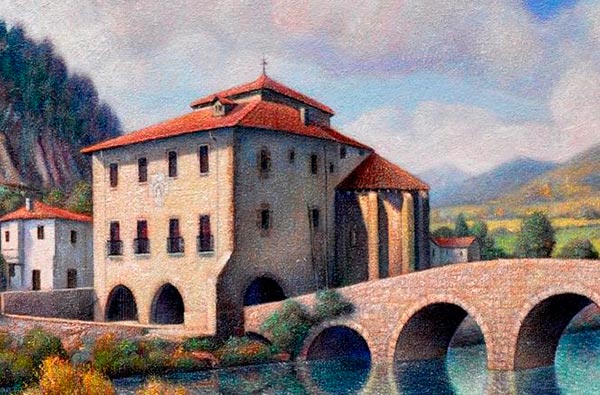
Narciso Rota, The Trinity of Arre, 1988. Private collection. Detail. Photo: M.ª Josefa Tarifa.
The painting allows us to appreciate a large part of the Romanesque apse of the church, which is the structure of the stone building that has undergone the fewest transformations throughout history, with its characteristic semicircular shape and reinforced by three buttresses that reach the red tile roof, once made of stone slabs, with the fourth abutment that runs along it at the other end of the presbytery hidden from our view, between which runs an eave of smooth corbels. Rota's observant eye also reproduces the semicircular lighting opening on the right side of the chancel, capturing with great precision the impact of the sun's rays on the apse, with some parts being more illuminated and others more obscured by the shadows. Behind the chancel, Rota draws the exterior of the sacristy, erected in the 16th century and remodeled in the 19th century, as well as the hospital of this charitable complex, which give way to the green meadow framed by the mountains in the background, today less visible from this same point of view due to the lush vegetation that grows on the banks of the river.
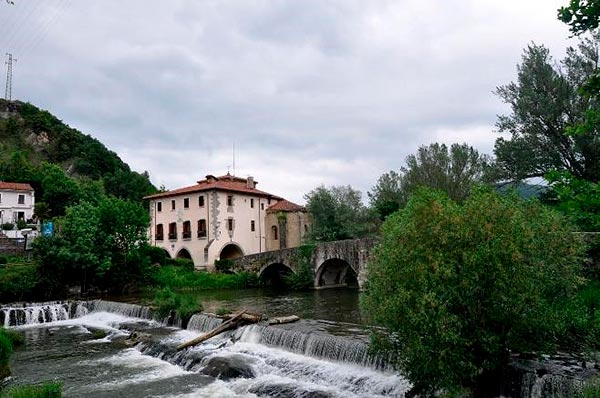
Current view of the medieval bridge and the Trinity of Arre. Photo: M.ª Josefa Tarifa.
The rest of the medieval construction of the church, consisting of a nave of three rectangular sections, closed with a slightly pointed barrel vault reinforced by transverse arches, which is attached to the chancel covered by an oven vault, is hidden by the construction carried out in the early twentieth century, attached to the side of the epistle of the temple, giving the architectural ensemble an eclectic look dominant among the architects of Pamplona in the early decades of this century. This building has served as residency program to the religious community that has inhabited it until a few years ago, although it is currently used as a pilgrims' hostel.
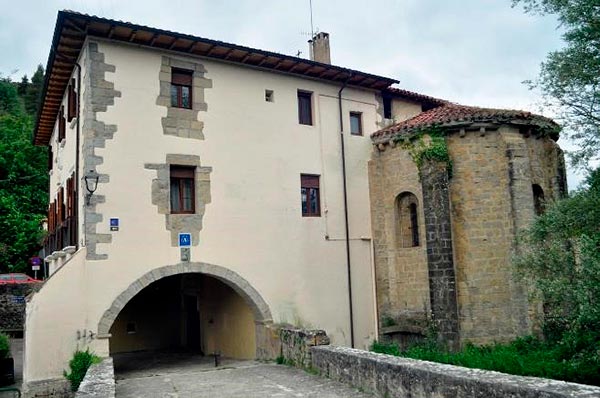
Pilgrims' hostel and apse of the Basilica of La Trinidad de Arre. Photo: M.ª Josefa Tarifa.
Rota's canvas faithfully captures the appearance of the southern façade, which consists of a base formed by two pointed arches, behind which is a vestibule that communicates with the entrance to the church, followed by the two levels of height of the residency program in which balconies are regularly arranged on the lower floor and rectangular windows on the upper floor, with straight frames, like an alfiz, a frame that also presents the relief with the Sacred Heart of Jesus in the central part of the façade. The painter also reproduces even the smallest detail of the eastern wall of the residency program, adjacent to the apse, from the straight lighting openings with stone frames, to the drainage gutters as they were at that time, as can also be seen in the photographs taken by the authors of the Catalog Monumental de Navarra at the beginning of the 1990s, ducts that were later replaced by others. Above this building, the top of the baroque bell tower of brick and red tile roof, which in the 18th century replaced the original stone one at the foot of the church, stands out slightly.
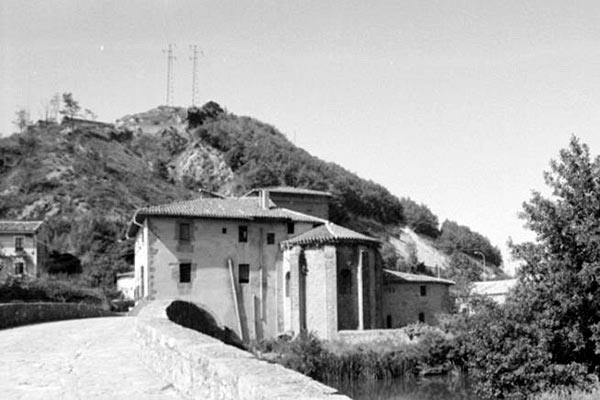
Basilica of the Trinity of Arre from the medieval bridge. Photo: Catalog Monumental de Navarra (1994).
Still standing today are the houses on the other side of the road that leads to Villava, behind which is Mount Ezkaba, whose high hill rises on the canvas under a blue sky, overcast with cottony white clouds.
The painting is signed in black pigment in the lower right corner, with the characteristic rubric of Narciso Rota, in which the right vertical line of the N and the left vertical stroke of the R appear merged, which probably made the author of the record of this work in the Catalog of the auction house think that it was an A, attributing, therefore, the canvas to a certain A. Rota. We can also specify the date of execution, 1988, as indicated by the two eights at the bottom of the letters.
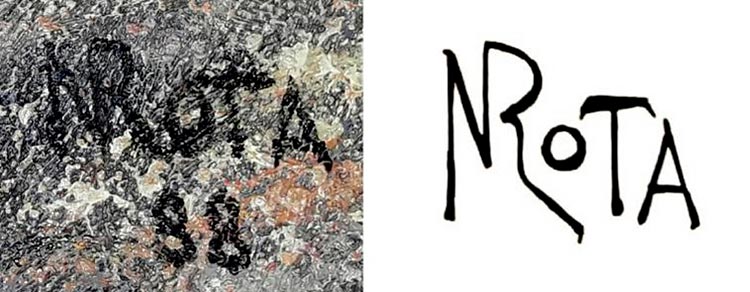
In final, as José María Muruzábal has pointed out, the outstanding artistic production of Narciso Rota has made him worthy of being part of the most important group of plastic artists who have played a leading role in Navarrese painting in the second half of the 20th century, among which are such outstanding figures as Jesús Lasterra, César Muñoz Sola, Miguel Ángel Echauri, José Antonio Eslava, Jurio Martín Caro, Salvador Beunza, José María Apezetxea, Elías Garralda, Francisco Buldain or Ana María Marín, among others, most of whom are also landscape painters.
SOURCES AND BIBLIOGRAPHY
GARCÍA GAINZA, M.ª C., ORBE SIVATTE, M., DOMEÑO MARTÍNEZ DE MORENTIN, A. and AZANZA LÓPEZ, J. J., Catalog Monumental de Navarra, V*. Merindad de Pamplona, Pamplona, Institución Príncipe de Viana, 1994, pp. 648-649.
MARTÍN-CRUZ, S. (dir.), "Narciso Rota. El paso desde el mundo artesanal", Pintores navarros II, Pamplona, Caja de Ahorros Municipal de Pamplona, 1982, pp. 118-125.
MURUZÁBAL DEL SOLAR, J. M.ª, "El pintor Narciso Rota", Pregón, n.º 47, March 2017, pp. 8-13.
MURUZÁBAL DEL SOLAR, J. M.ª, "Narciso Rota, official document and art", Diario de Navarra, Tuesday, April 23, 2019, p. 54.
PASTOR ABÁIGAR, V., La Trinidad de Arre. Historia en torno a sus edificios adjuntos. Defensa de su patrimonio ante la Desamortización, Pamplona, Ulzama Ediciones, 2014.
